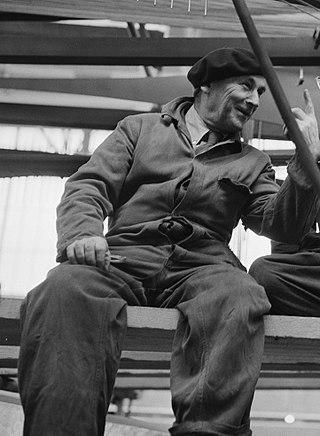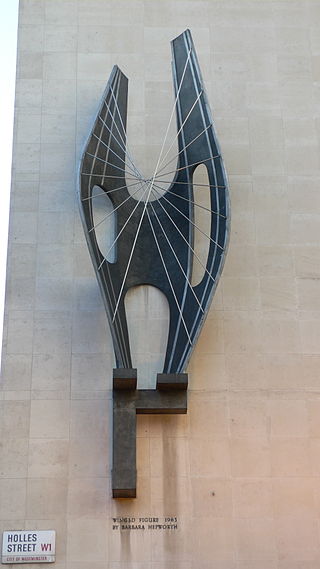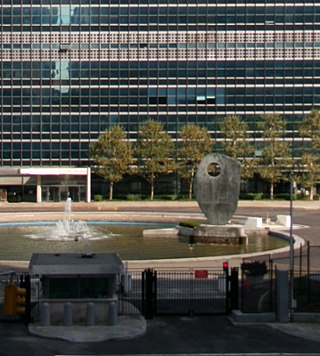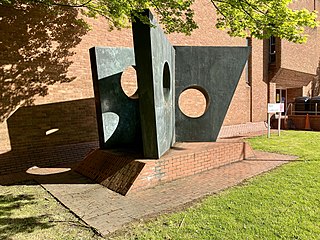Related Research Articles

Dame Jocelyn Barbara Hepworth was an English artist and sculptor. Her work exemplifies Modernism and in particular modern sculpture. Along with artists such as Ben Nicholson and Naum Gabo, Hepworth was a leading figure in the colony of artists who resided in St Ives during the Second World War.

Sir Jacob Epstein was an American-British sculptor who helped pioneer modern sculpture. He was born in the United States, and moved to Europe in 1902, becoming a British subject in 1910.

Benjamin Lauder Nicholson, OM was an English painter of abstract compositions, landscapes, and still-life. He was one of the leading promoters of abstract art in his country.

The Barbara Hepworth Museum and Sculpture Garden in St Ives, Cornwall preserves the 20th-century sculptor Barbara Hepworth's studio and garden much as they were when she lived and worked there. She purchased the site in 1949 and lived and worked there for 26 years until her death in a fire on the premises in 1975.

Naum Gabo, born Naum Neemia Pevsner, was an influential sculptor, theorist, and key figure in Russia's post-Revolution avant-garde and the subsequent development of twentieth-century sculpture. His work combined geometric abstraction with a dynamic organization of form in small reliefs and constructions, monumental public sculpture and pioneering kinetic works that assimilated new materials such as nylon, wire, lucite and semi-transparent materials, glass and metal. Responding to the scientific and political revolutions of his age, Gabo led an eventful and peripatetic life, moving to Berlin, Paris, Oslo, Moscow, London, and finally the United States, and within the circles of the major avant-garde movements of the day, including Cubism, Futurism, Constructivism, the Bauhaus, de Stijl and the Abstraction-Création group. Two preoccupations, unique to Gabo, were his interest in representing negative space—"released from any closed volume" or mass—and time. He famously explored the former idea in his Linear Construction works (1942-1971)—used nylon filament to create voids or interior spaces as "concrete" as the elements of solid mass—and the latter in his pioneering work, Kinetic Sculpture (1920), often considered the first kinetic work of art.

Sir Alan Bowness CBE was a British art historian, art critic, and museum director. He was the director of the Tate Gallery between 1980 and 1988.

Henry Spencer Moore was an English artist. He is best known for his semi-abstract monumental bronze sculptures which are located around the world as public works of art. Moore also produced many drawings, including a series depicting Londoners sheltering from the Blitz during the Second World War, along with other graphic works on paper.
Denis Adeane Mitchell was an English abstract sculptor who worked mainly in bronze and wood. A prominent member of the St Ives group of artists, he worked as an assistant to Barbara Hepworth for many years.

Margaret Nairne Mellis was a Scottish artist, one of the early members and last survivors of the group of modernist artists that gathered in St Ives, in Cornwall, in the 1940s. She and her first husband, Adrian Stokes, played an important role in the rise of St Ives as a magnet for artists. She later married Francis Davison, also an artist, and became a mentor to the young Damien Hirst.

Two Forms (Divided Circle) (BH 477) is a bronze sculpture by Barbara Hepworth, designed in 1969. Six numbered copies were cast, plus one (0/6) retained by the sculptor. The sculpture's dimensions are 237 centimetres (93 in) by 234 centimetres (92 in) by 54 centimetres (21 in).

Sphere with Inner Form is a bronze sculpture by English artist Barbara Hepworth, with six castings made in 1963 and two more 1965. It is sometimes interpreted as a child in a pregnant woman's womb, or as a metaphor for the creation of a sculpture.
Kim Lim (1936–1997) was a Singaporean-British sculptor and printmaker of Chinese descent. She is most recognized for her abstract wooden and stone-carved sculptures that explore the relationship between art and nature, and works on paper that developed alongside her sculptural practice. Lim's attention to the minute details of curve, line and surface made her an exponent of minimalism.

Winged Figure is a 1963 sculpture by British artist Barbara Hepworth. One of Hepworth's best known works, it has been displayed in London since April 1963, on Holles Street near the junction with Oxford Street, mounted on the south-east side of the John Lewis department store. It is estimated that the sculpture is seen by approximately 200 million people each year.

Single Form is a monumental bronze sculpture by the British artist Barbara Hepworth. It is her largest work, and one of her most prominent public commissions, displayed since 1964 in a circular water feature that forms a traffic island at the Headquarters of the United Nations in New York City, outside the United Nations Secretariat Building and the Dag Hammarskjöld Library. It is also the largest artwork cast by the Morris Singer foundry.
Meridian is a bronze sculpture by British artist Barbara Hepworth. It is an early example of her public commissions, commissioned for State House, a new 16-storey office block constructed at 66–71 High Holborn, London, in the early 1960s. The sculpture was made in 1958–59, and erected in 1960. When the building was demolished in 1992, the sculpture was sold and moved to the Donald M. Kendall Sculpture Gardens in Purchase, New York.
Four-Piece Composition: Reclining Figure (LH154) is an important early stone sculpture by the English sculptor Henry Moore. He had been working on depictions of the reclining human figure since at least 1924, but this small piece, made in the latter half of 1934, is the first work in which Moore breaks a human figure down in to several separate pieces. It was acquired by the Tate Gallery in 1976.

Locking Piece is a sculpture by Henry Moore. It comprises two interlocking forms holding a third element between them, on a bronze base. It is usually mounted on a separate plinth. The sculpture was created in 1962–1964, and bronze casts were made in 1964–1967.

Four-Square is a 4.3 metres (14 ft) high bronze sculpture by British artist Barbara Hepworth. It was cast in 1966 in an edition of 3+1. The four casts are displayed at the Barbara Hepworth Museum, the Norton Simon Museum, Churchill College, Cambridge, and the Mayo Clinic.

Brian Wall is a British-born American sculptor now living in California. His work consists mainly of abstract welded steel constructions, and his career stretches over six decades. He has had numerous solo shows, and his sculptures reside in many private and museum collections. He was a faculty member at the Central School of Art in London, and a professor of art at the University of California, Berkeley.

Three Obliques (Walk In) is a 1968 sculpture by Barbara Hepworth. Three casts exist; two are in private collections and a third is displayed outside the Cardiff University School of Music in Cardiff, Wales. It is cast in bronze on a monumental scale.
References
- barbarahepworth.org.uk
- Work of the week: Three Forms by Barbara Hepworth, Tate Gallery
- Three Forms, Tate Gallery
- Three Forms (Carving in Grey Alabaster), Tate Gallery (a similar work from 1935, in grey alabaster)
- Three Forms (Carving in Grey Alabaster), catalogue entry, Tate Gallery
- How to Write Art History, Anne d'Alleva, p. 38
- Art In The Making: Aesthetics, Historicity And Practice, Kerstin Mey, p. 190-3